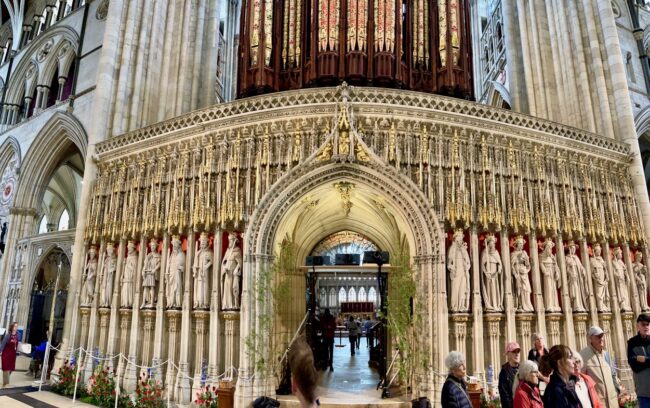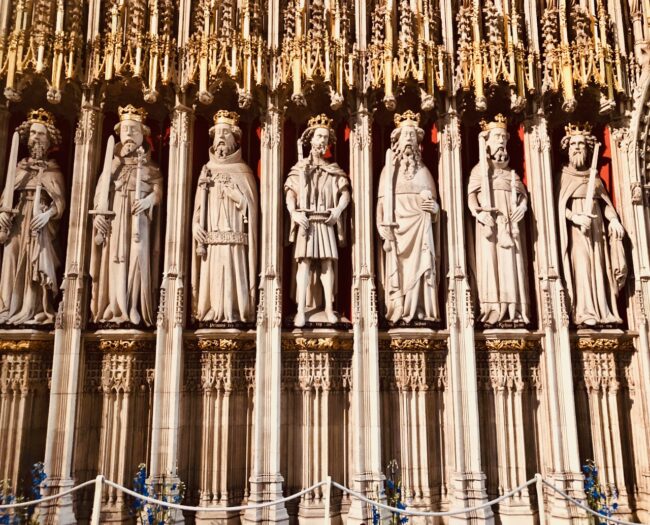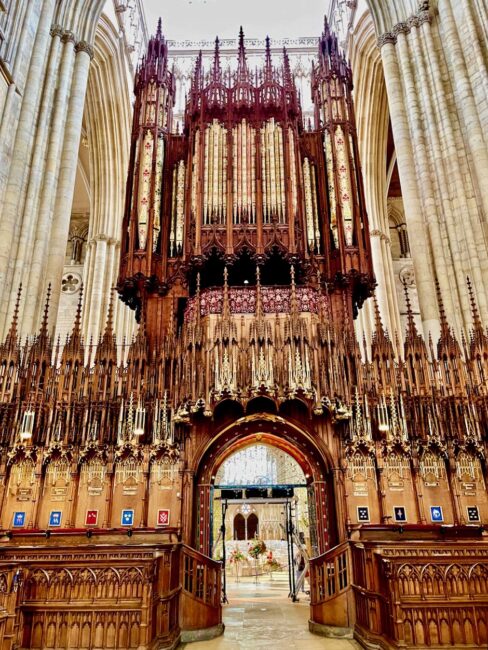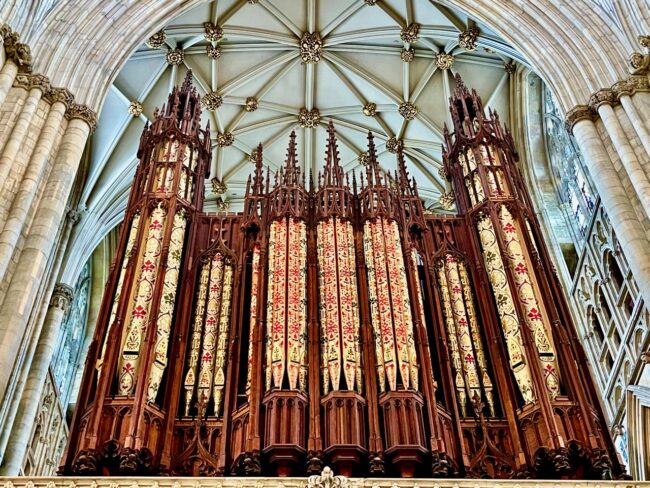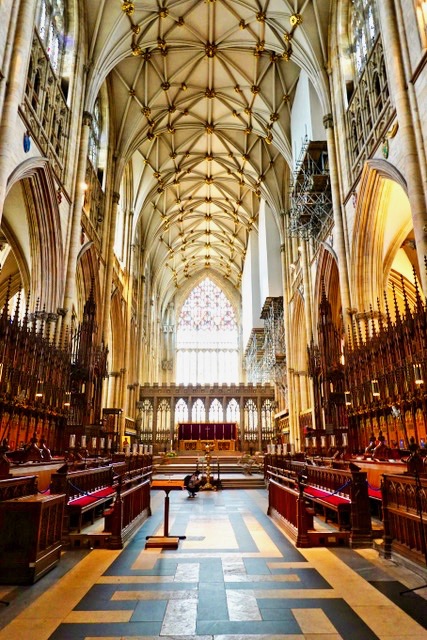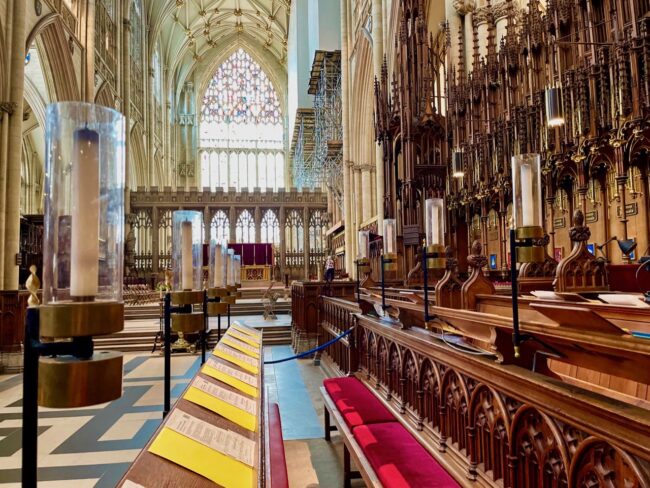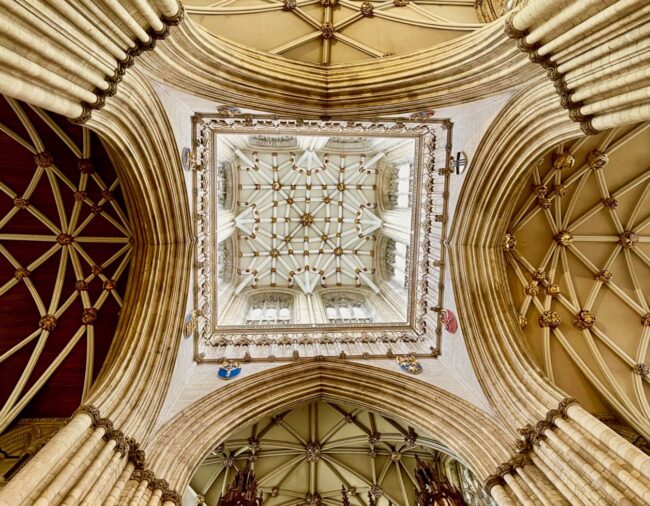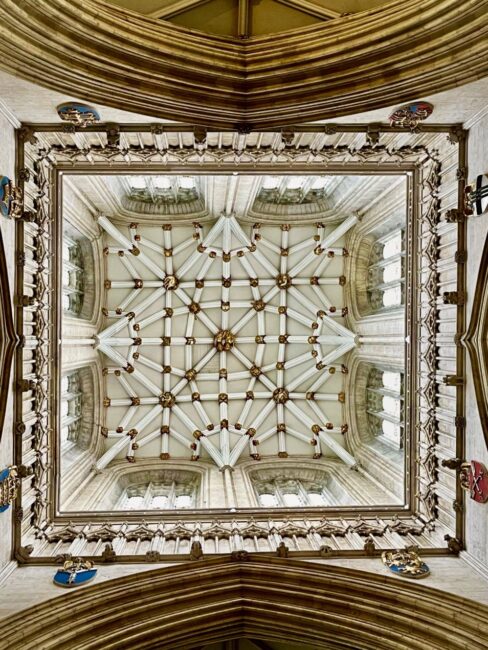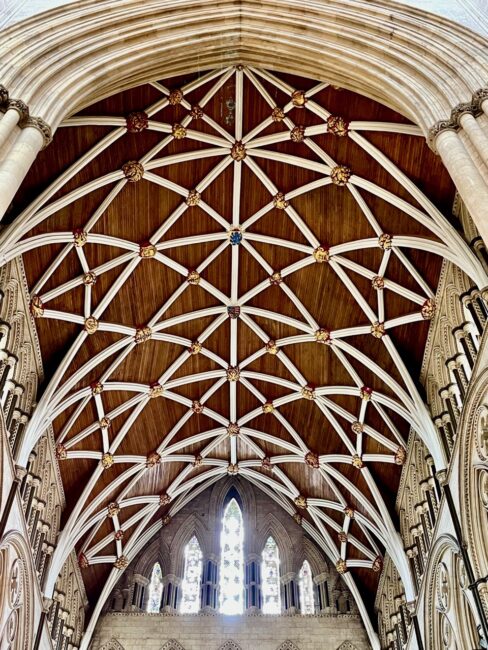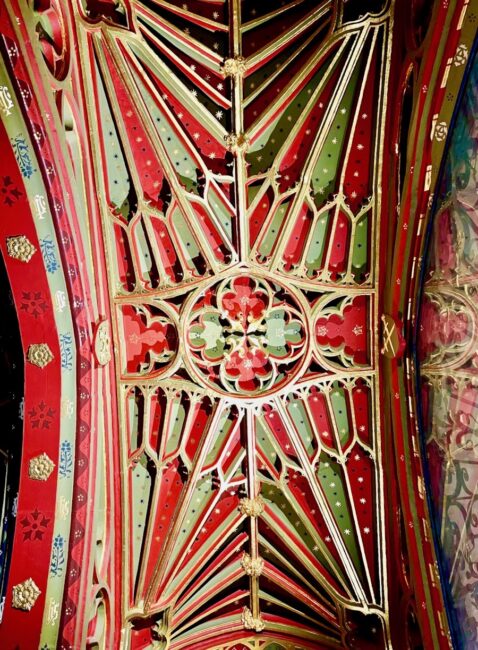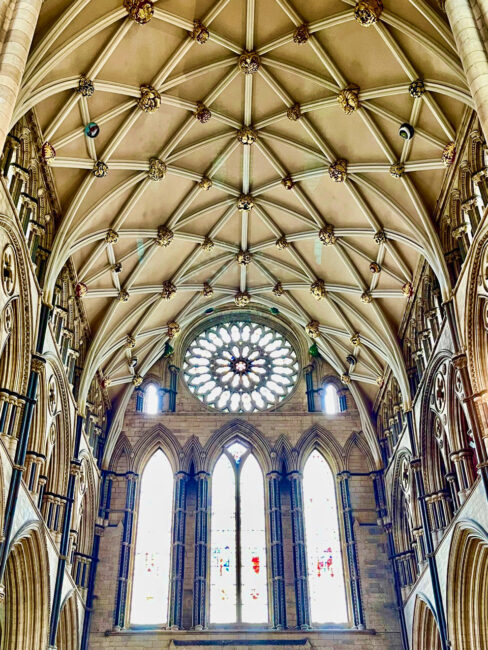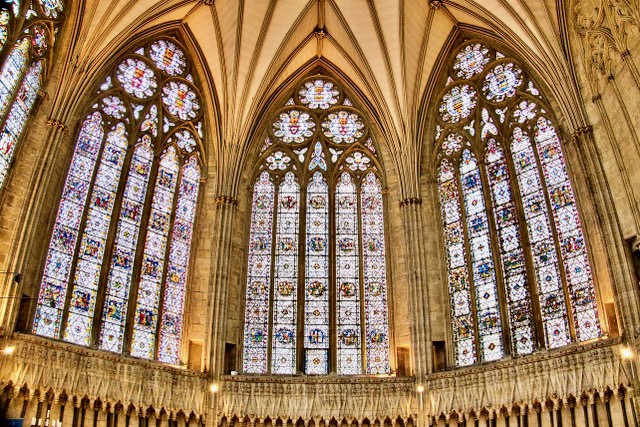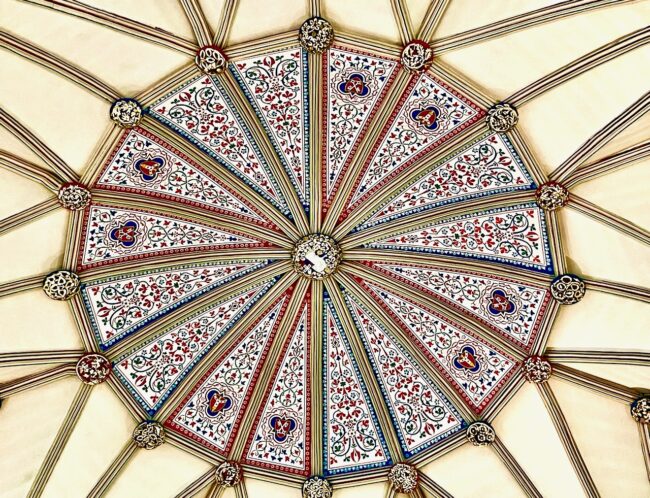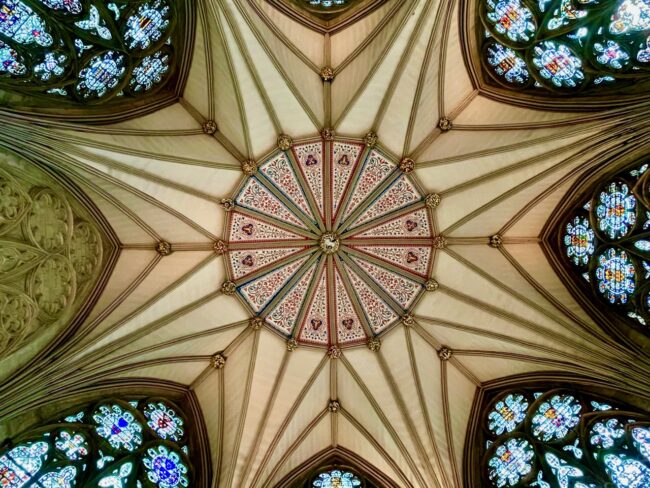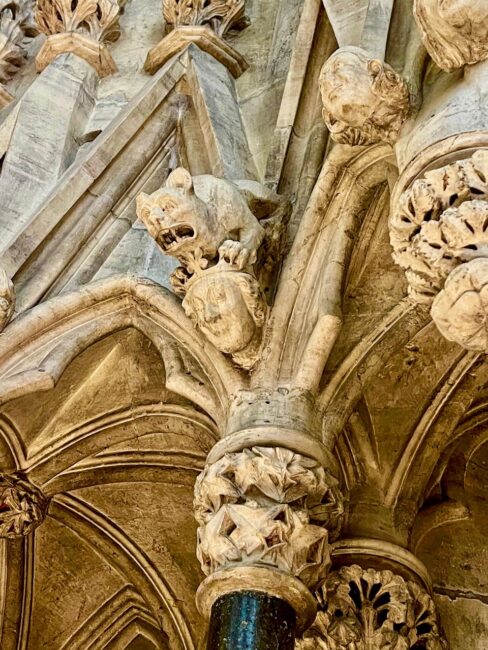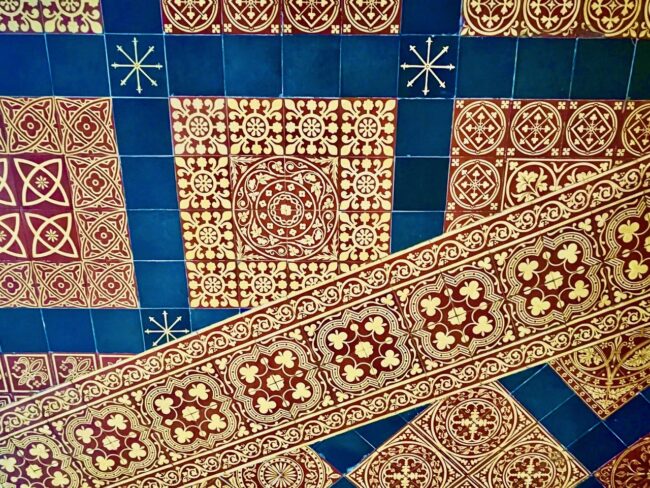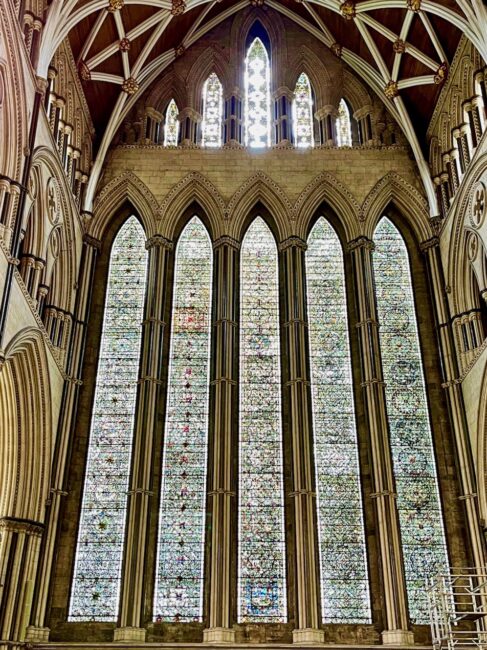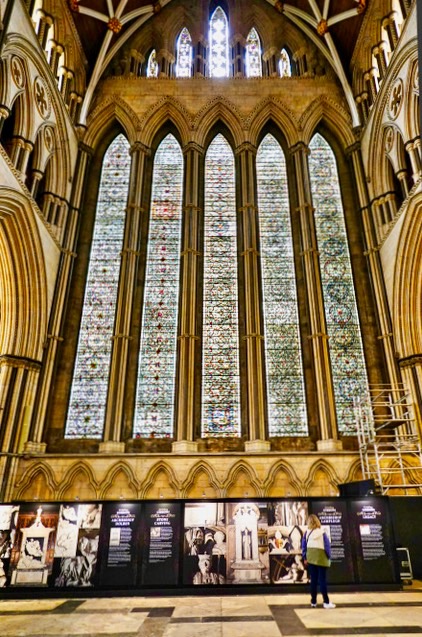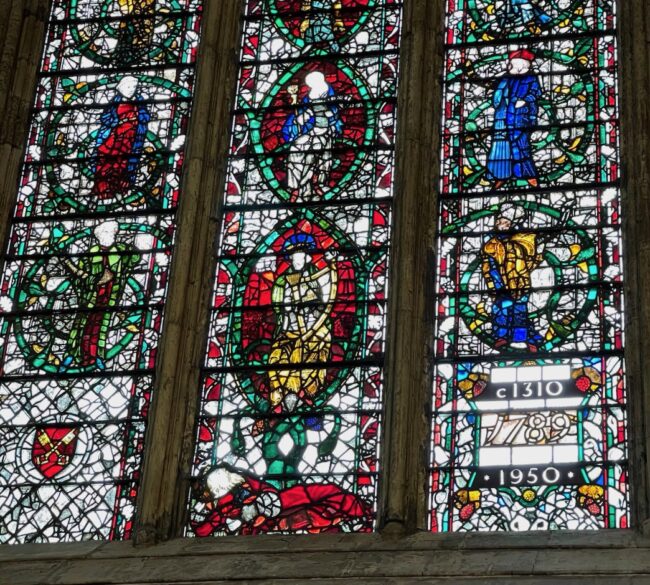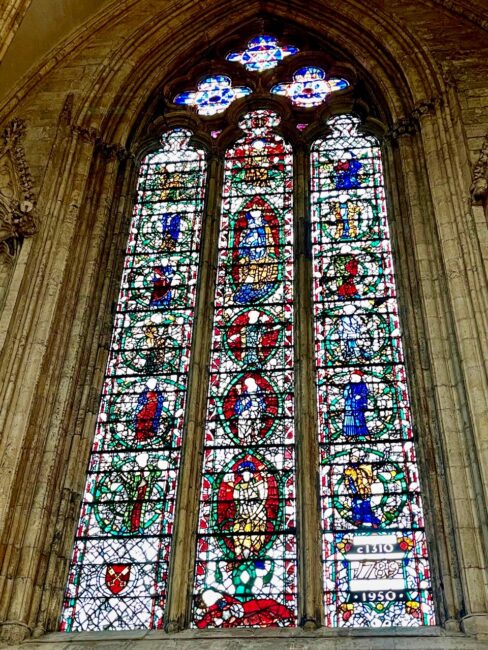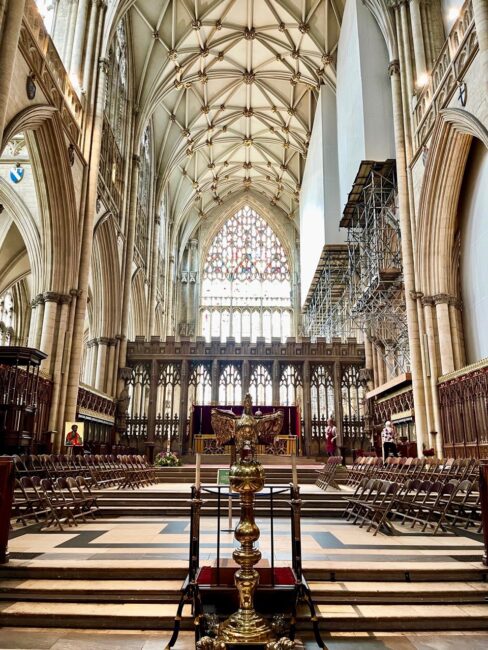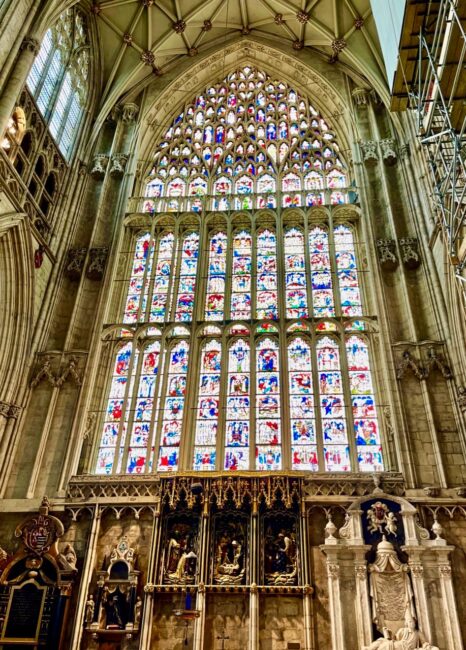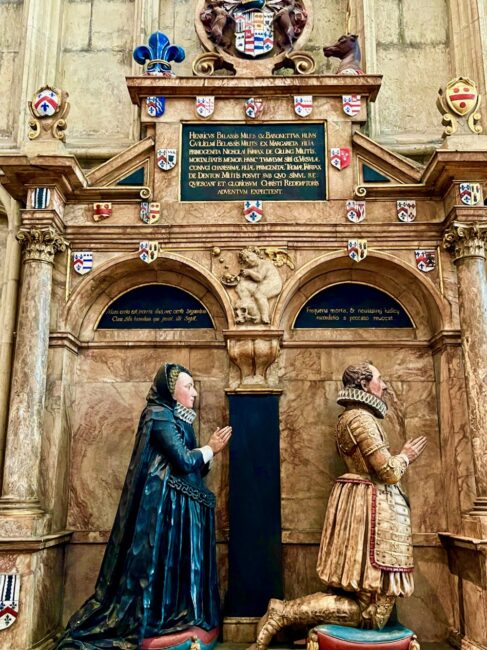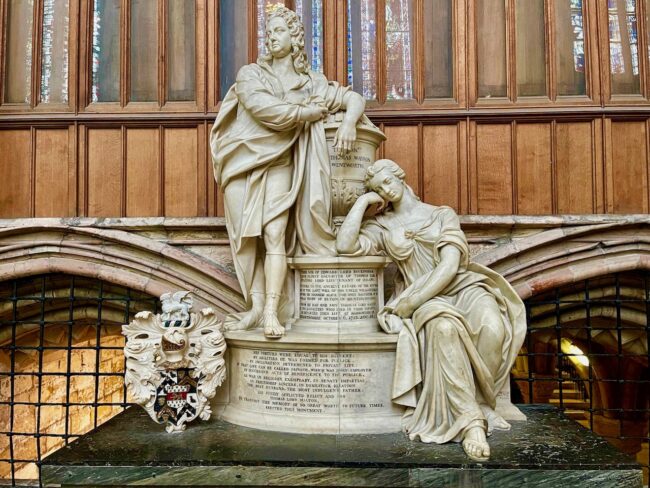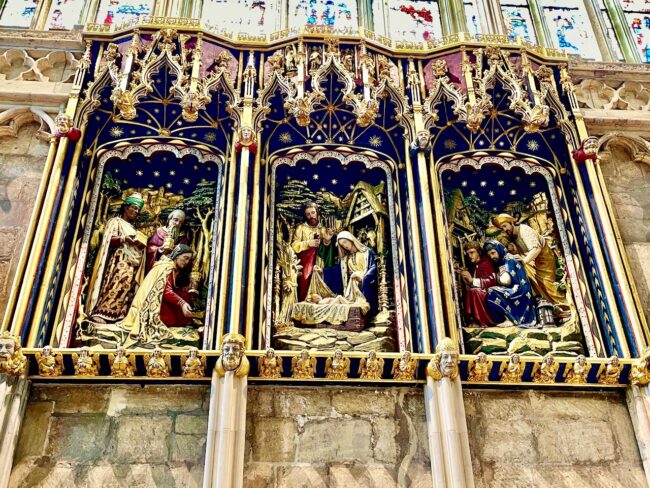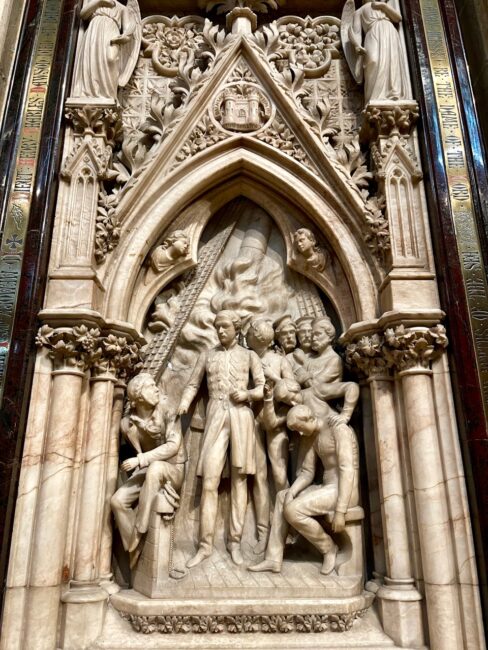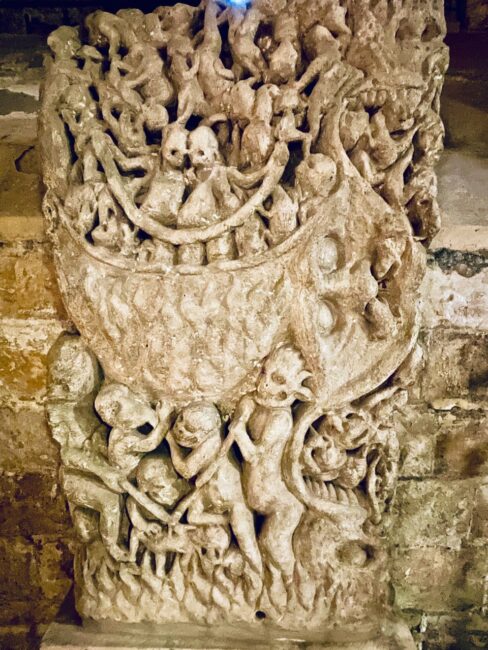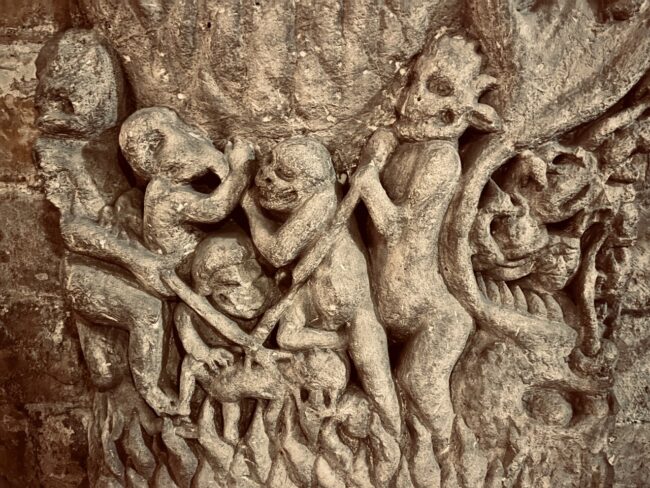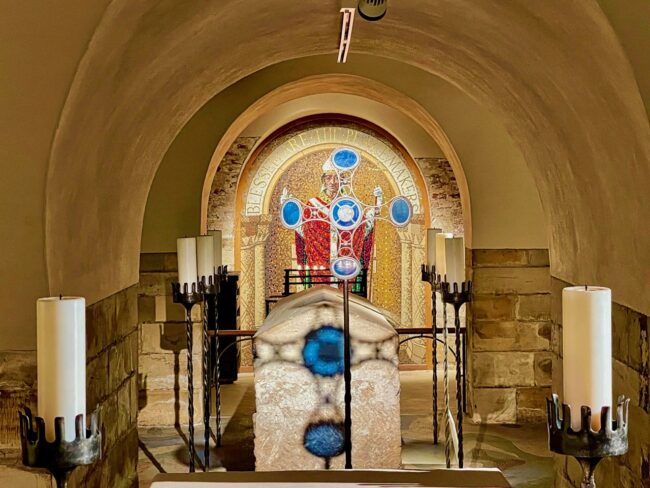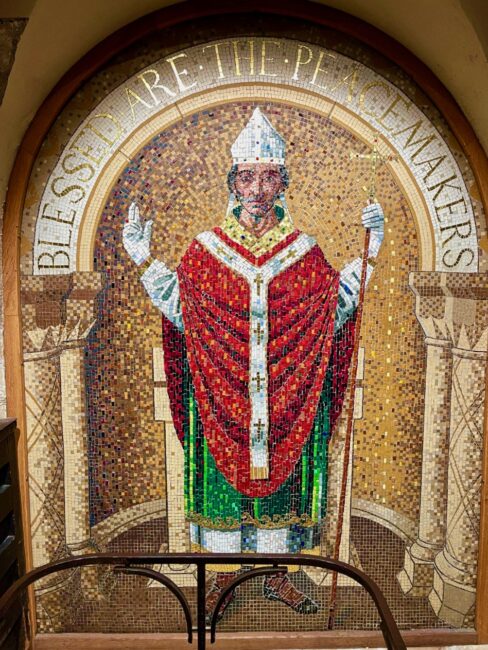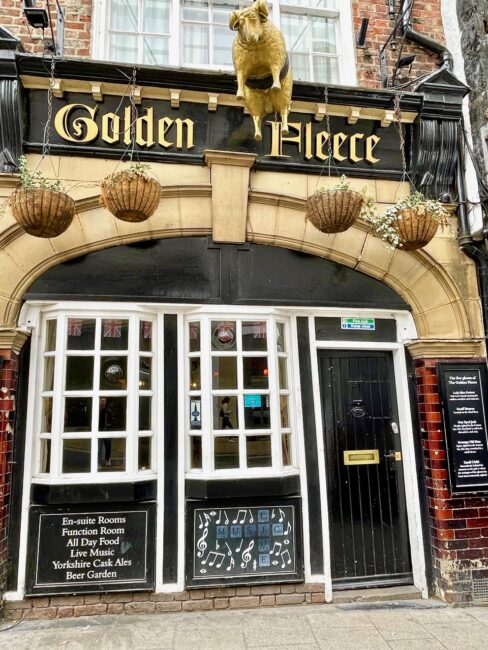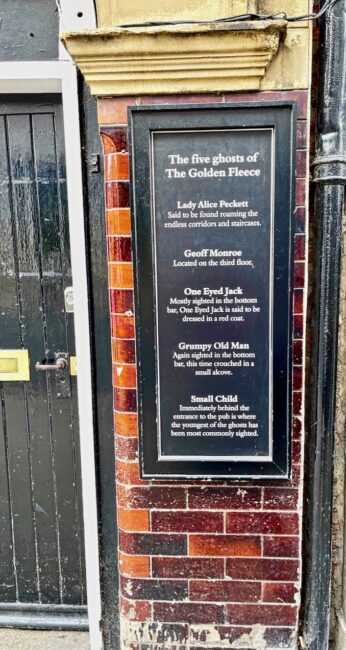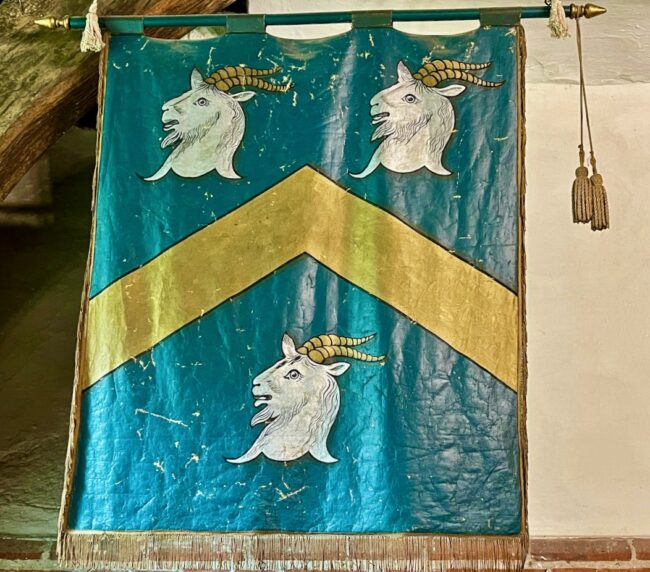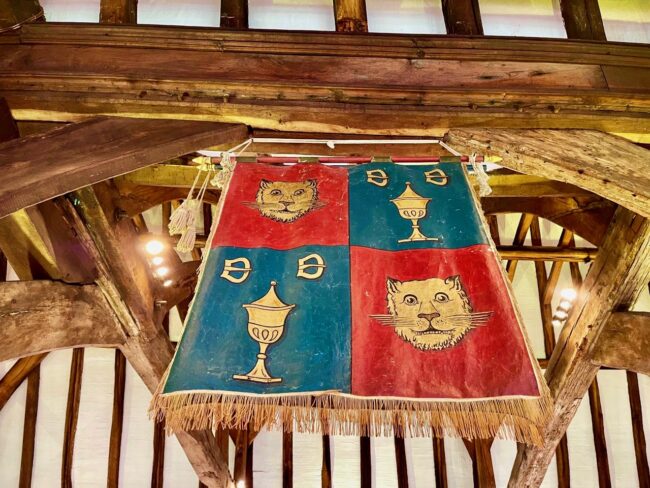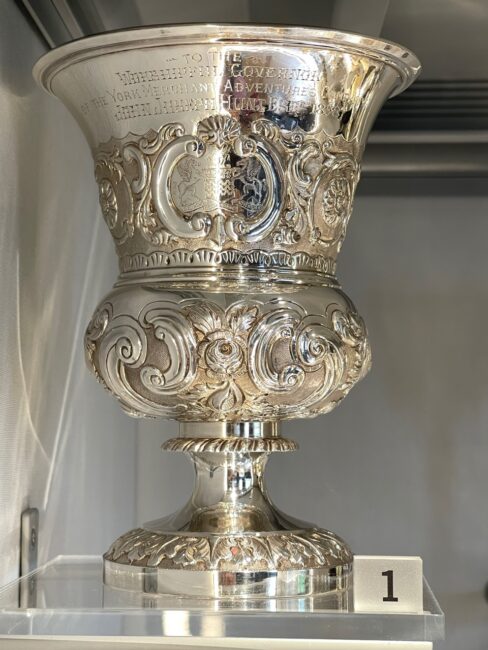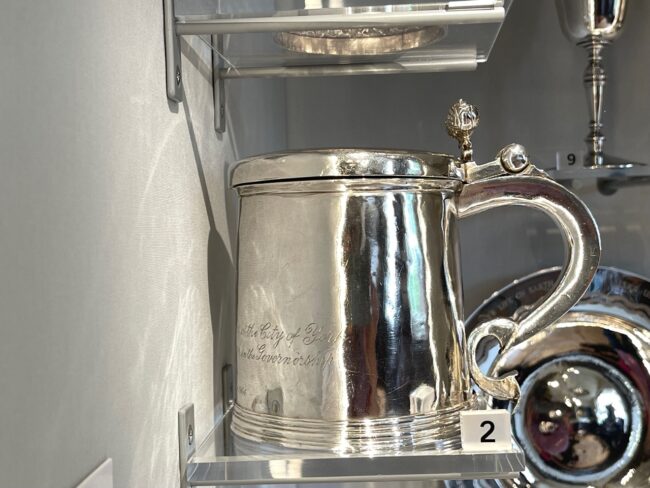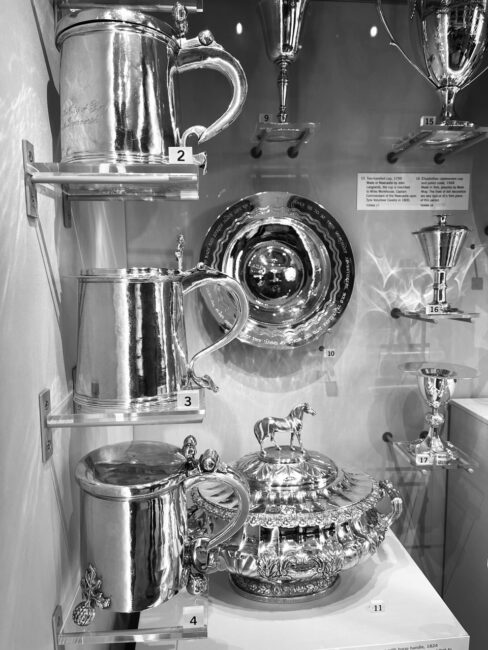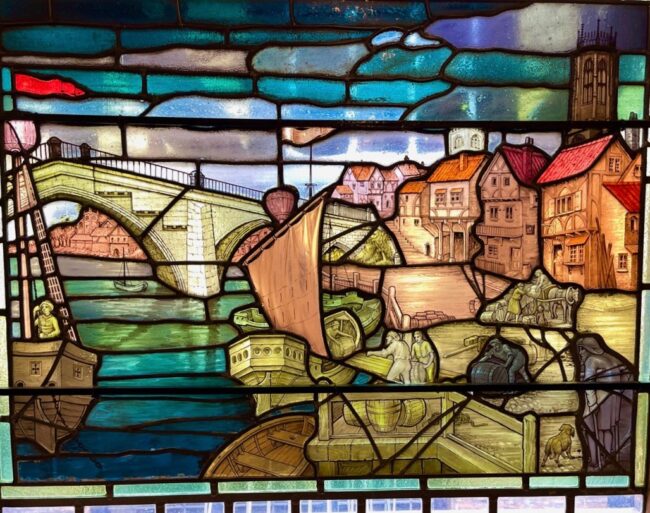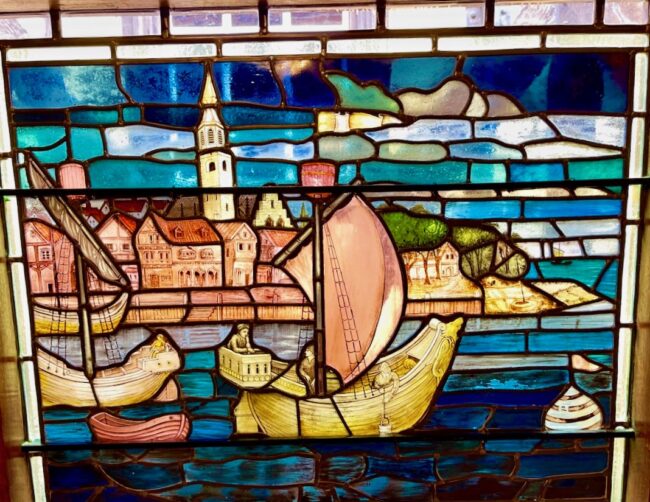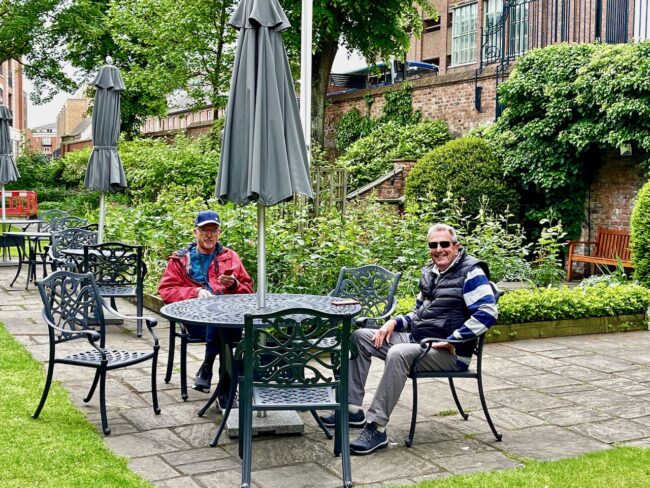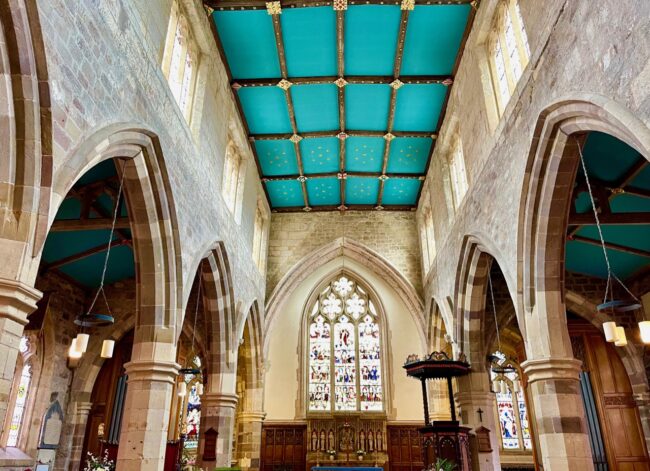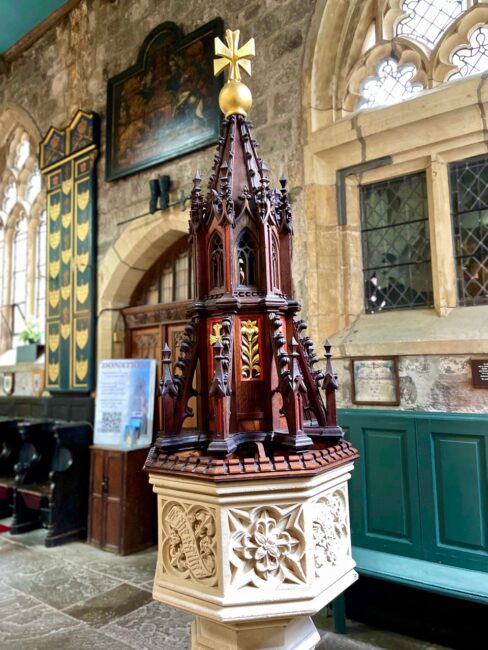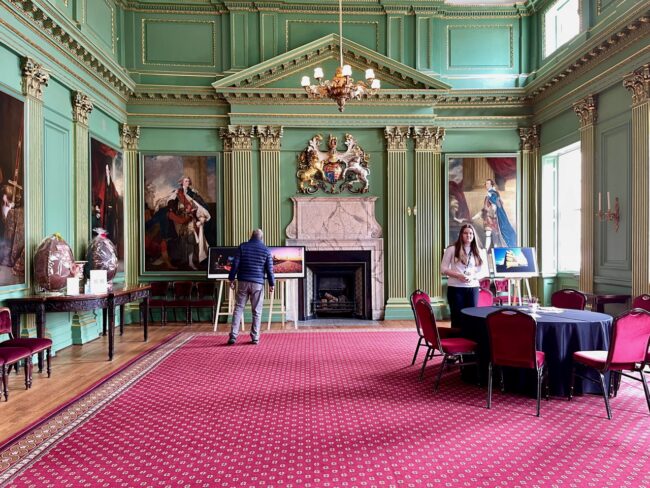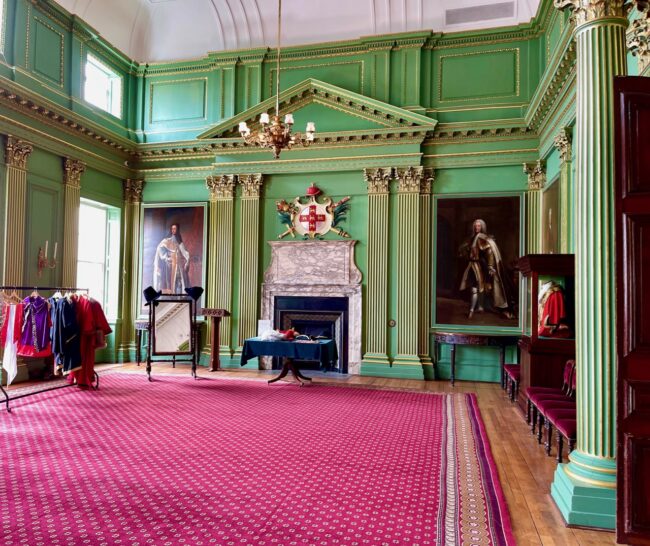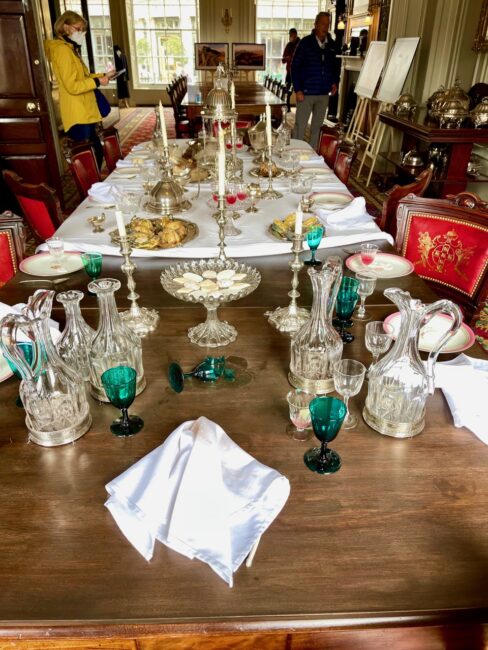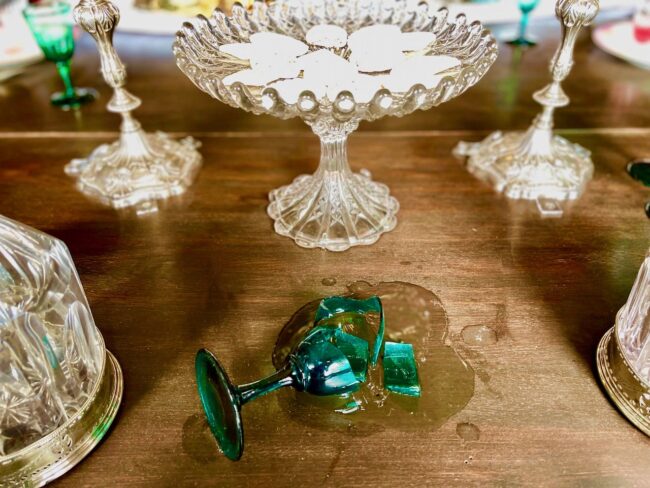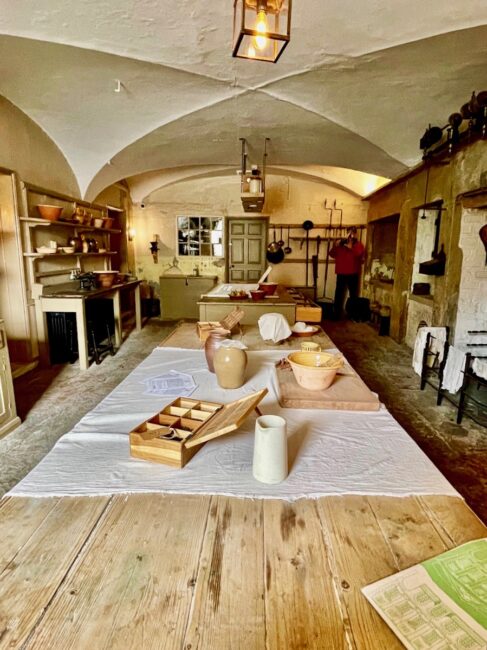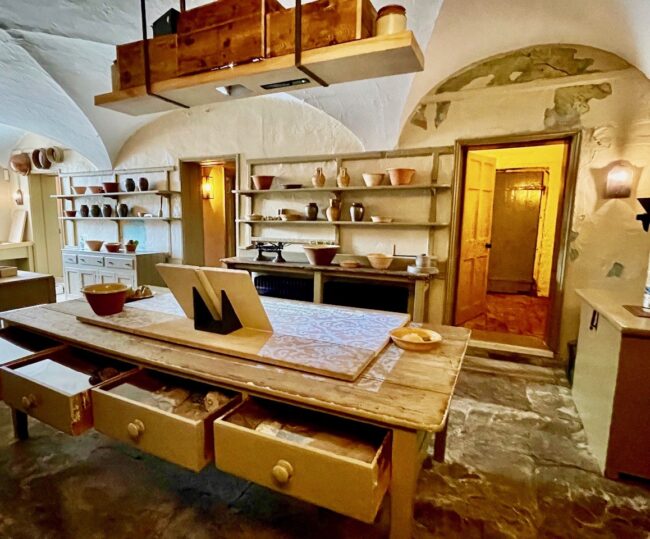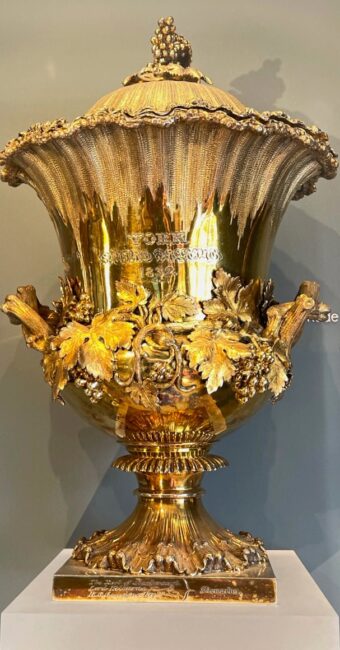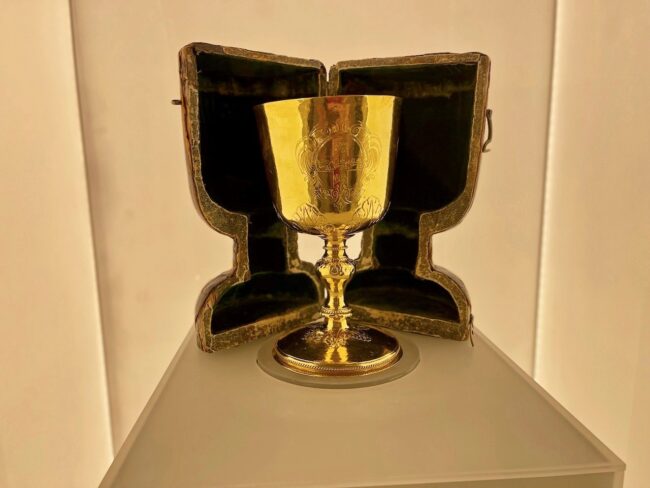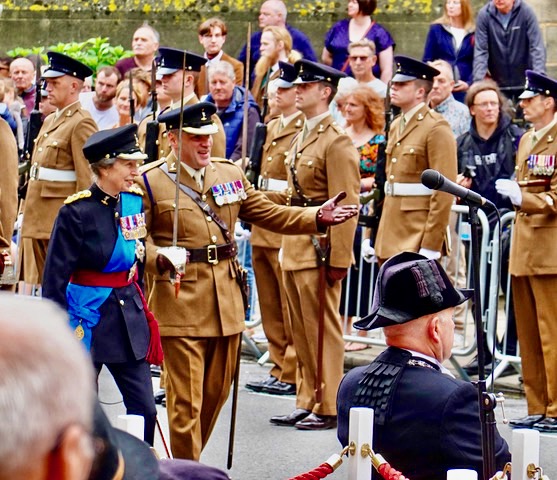
CHAPTER FIVE: An Incident In York & Hitting The Walls
July 7, 2022
CHAPTER SEVEN: An Abbey For The Ages & On To Durham
July 16, 2022Surviving Mai Tai Tom’s “Royal” Blunder: 2022 England & Scotland
CHAPTER SIX: Final Day In York – Minster, Merchant & Mansion
Day Six: Phew!, I Forgot My Tux, Hitting the “Pavement,” Medieval Merchants, I Hope She’s Not Here, Not Even Close To Sunset Dinner and Somewhere Over The Rainbow
Meeting Mary at breakfast, I thought I heard her blurt out, “Last night I left my purse in the Forest.” Thinking she was kidding, I replied, “Hopefully Robin Hood will find it.” She then told me that Forest is where they dined the previous evening. Our lodging called the restaurant and, sure enough, Mary’s purse was there, credit cards, passports and all. They went to pick it up.
We met back up at the entrance to the York Minster, where we had 9:45 timed tickets. 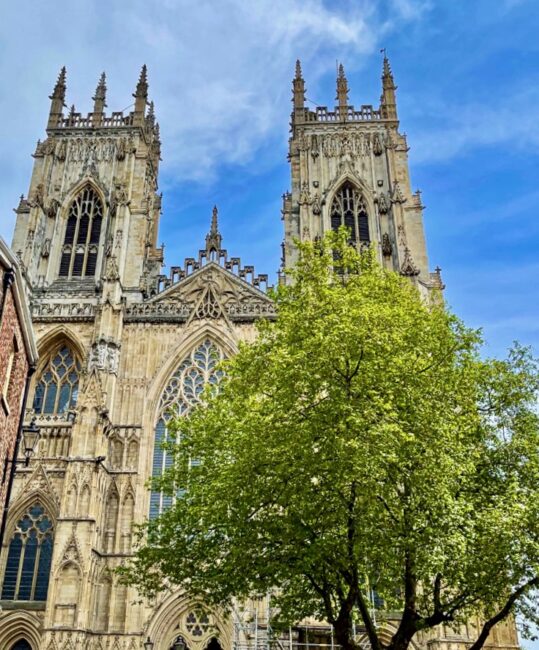
Once inside, we were informed of an hourlong free tour, so we decided we’d take it, because (1) York Minster is massive (the largest Gothic cathedral in northern Europe) and (2) it was free. 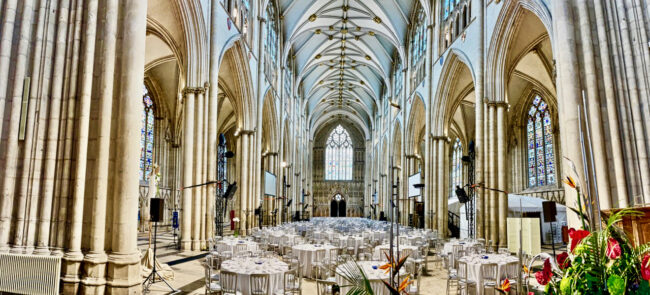 It’s called a Minster instead of a cathedral because that was the term used back in the Anglo-Saxon days, although its official name is The Cathedral and Metropolitical Church of St. Peter in York. The interior of the Minster was not set up for services on this day, but instead a multitude of round tables filled the nave.
It’s called a Minster instead of a cathedral because that was the term used back in the Anglo-Saxon days, although its official name is The Cathedral and Metropolitical Church of St. Peter in York. The interior of the Minster was not set up for services on this day, but instead a multitude of round tables filled the nave.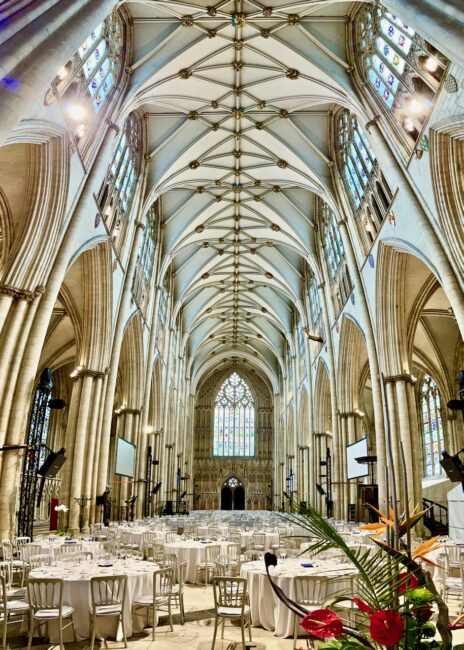
We were told that the tables were being set-up for a black tie fundraiser that evening. Price for a table was $2,500, and when we heard that news, Mary tried to lose her purse again in case she was invited.
Arthur Purey has a colorful memorial. Purey was an author who catalogued the Minster’s heritage during his 36 years as the Dean of York. I guess “v” was a “u” back then.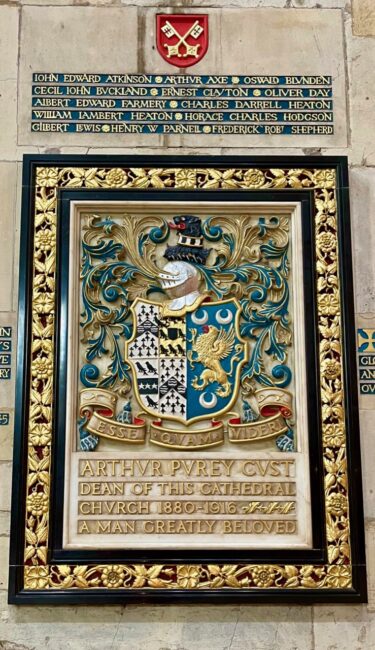
The Stone Pulpitum (otherwise known as the Choir Screen) is “the most elaborate surviving example in any English cathedral.”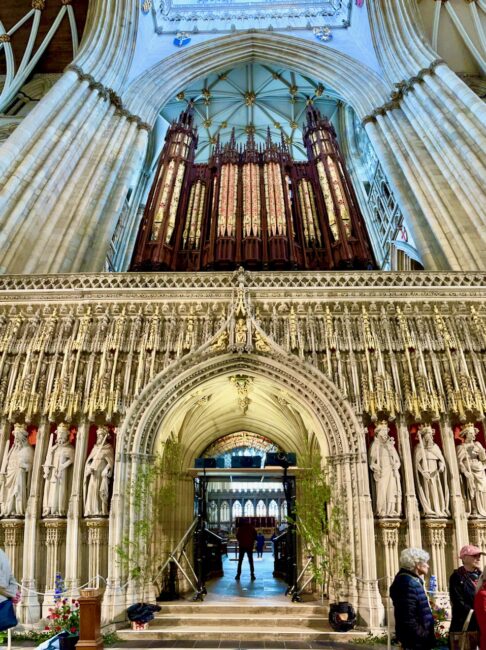
The Pulpitium forms the west entrance to the choir. It dates from the 15th century, and the Gallery of the Kings includes 15 statues from William The Conqueror (the guy on the left In the photo on the right) to Henry VI (the only non-medieval king).
There are roughly 5,400 pipes in The Grand Organ, one of the largest in all the United Kingdom. It underwent a £2 million refurbishment in 2018 and opened back up in 2021. Some of the pipes date back to the 1830s when it was installed.
Stepping through the Stone Pulpitum, we were in the choir. That’s the famed Great East Window in the background.
The Choir Master’s Lectern is distinctive, and you didn’t need an Eagle eye to find it.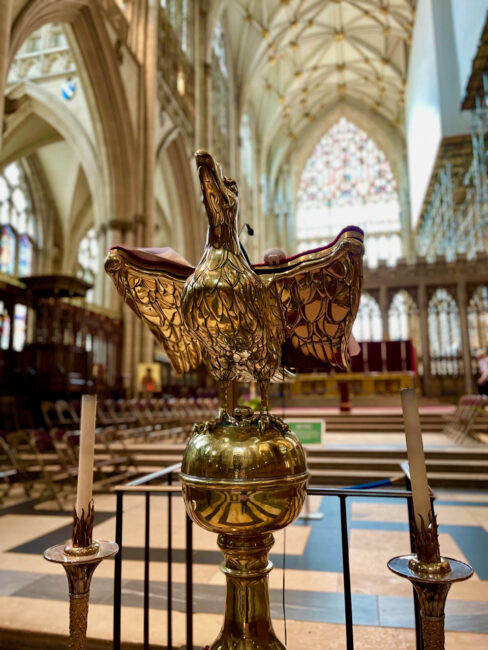
There’s no shortage of places to take photos.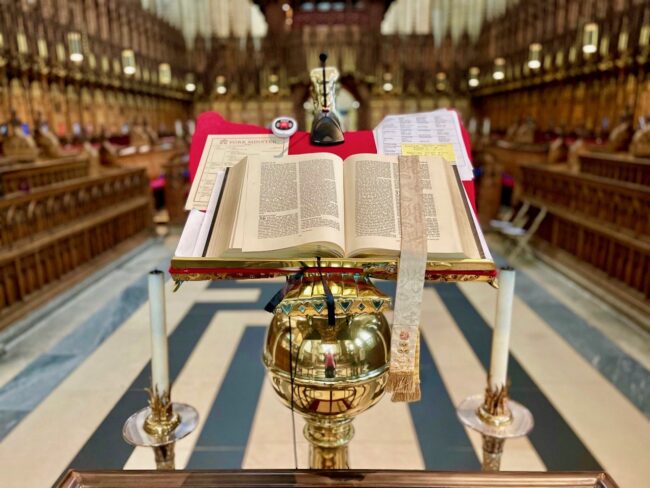
Our docent told us that the choir stalls needed to be replaced in 1829 when a “deranged man” set them and the organ on fire.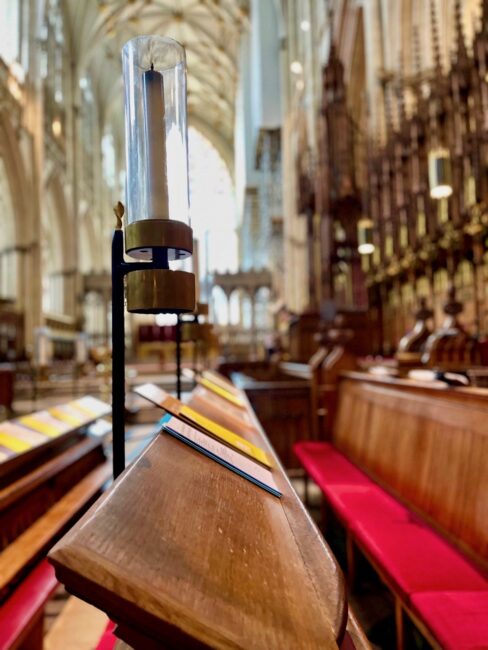
Throughout the tour Tracy and Kim once again risked serious neck injuries photographing the intricate ceiling designs like these from Tracy of the vaulted ceiling of the Central Tower.
Since I am now completely out of order, here are three more. The wooden roof had to be replaced in 1840 after a fire started by a candle left by a clock repairman. I don’t know it’s one of these ceilings, but after the fire, our guide told us that the roof was completely replicated with the only modification being the wooden medallions of the Virgin Mary feeding baby Jesus. It was changed to show Mary feeding Jesus with a bottle instead of breast feeding. How Victorian!
Fortunately, someone on the internet found it.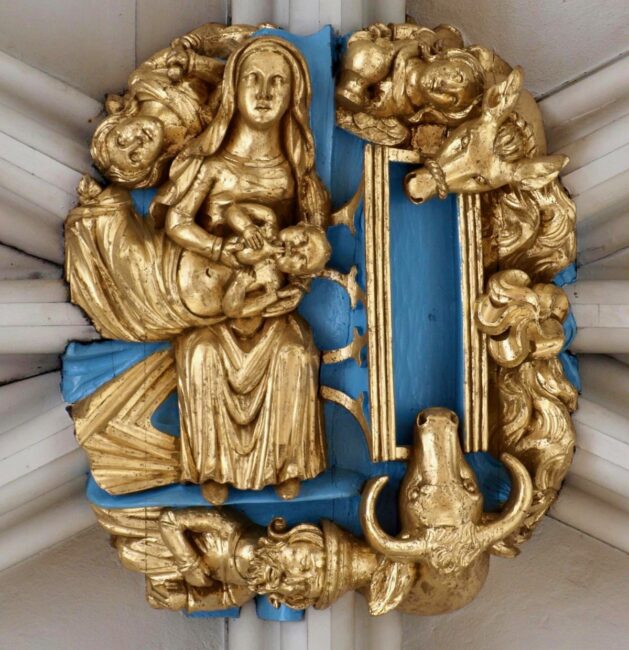
The Chapter House has been here since 1260, and it was all that it was advertised. Wow!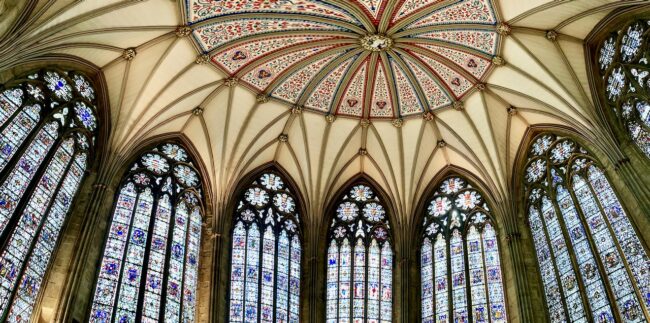
This circular space is where the day-to-day business of the church was run.
The ribbed ceiling is something to behold, with no central support for the roof. Our docent said more than 250 faces are carved into the stonework in this room.Coincidentally, the Minster took 250 years to be completed from 1220 to 1471. As the docent pointed out to put that in context, about as long as American independence (yes, our group was mostly comprised of Americans). Our docent said this one depicts a rat protecting the head of King Edward so it could be reunited with his body. Seems no body could keep their heads during that time.
I had to stop Tracy before she was permanently looking upward.
Showing her versatility, she could look down, too. Also of interest is the Minton tile floor.
The York Minster, according to our guide, contains over half the medieval windows in all of England. There are 128 of them, with 80 having been removed during World War II for safe keeping. Also according to our guide, in the 1980s, the 1515 Rose Window was struck by lightning and restored after cracking into 40,000 pieces (it originally had 7,000 pieces). Neither of my crack photographers were able to get a great shot of it (which paned me), so the below photo is from my friends at Wikipedia.
The Five Sisters Window goes all the way back to 1260. It contains 100,000 pieces.
The Jesse Tree Window dates back to 1310, and was restored in 1950. The window even tells you that.
The Great West window of York Minster was glazed in 1338. It contains the images of bishops and saints, and the “tracery flowers” (not Tracy flowers) into the shape of a heart; a fine example of the Gothic flamboyant style. 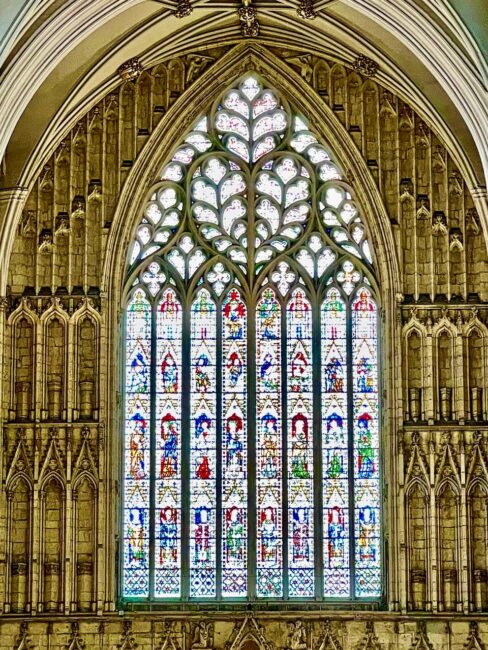
In the Lady Chapel you find the most famous of the stained glass windows, Great East Window, dubbed “The Sistine Chapel of Stained Glass.” It was completed in the early 1400s by John Thornton, who was paid £46 for his efforts plus a £10 bonus on completion. It’s the largest medieval stained glass window in Europe, at 79-feet tall incorporating 311 panes. The restoration project in 2015 cost £10.5 million. Also from the 1400s is the equally impressive St. Cuthbert’s Window. St. Cuthbert’s is on the right.
Statues abound. A monument to Sir Henry Belasyse is on the left while Thomas Watson-Wentworth is memorialized in photo on the right. His wife or girlfriend seems to be a tad bored with it all.
You could take hundreds of photos just of plaques and statues at York Minster.
The Astronomical Clock is “a memorial to the men of the Royal Air Forces of the Commonwealth and their Allies.”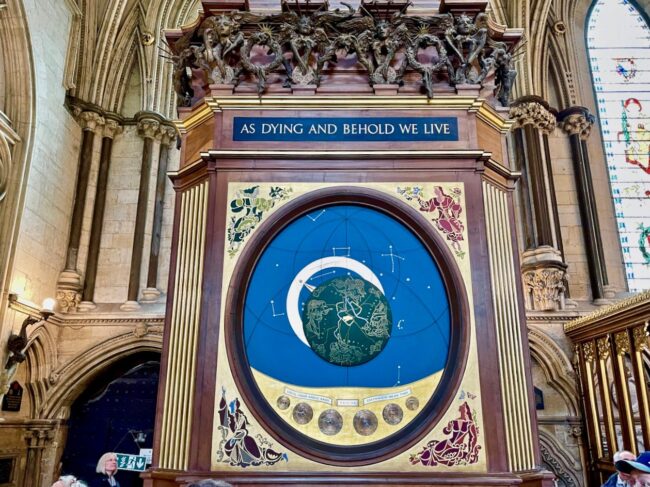
Descending into the Crypt, there are many points of interest, but two in particular. The first was the Doomstone, which goes all the way back to the first Norman Minster in the 12th century. It’s carved in limestone and features demons representing among other things, greed and lust. The sign said, “it shows Hell’s cauldron or the Mouth of Hell.”
Next up was the Tomb of St. William, the Patron Saint of York. In the mid 1100s he was made Archbishop by then Pope Anastastius IV. This was his second stint, but when he returned, so the story goes, so many people gathered on Ouse Bridge that it collapsed. William prayed for them, and nobody drowned. The sarcophagus is believed to contain his remains.
Before leaving the Minster, Tracy had just enough nerves left in her neck area to take one more tower ceiling photo.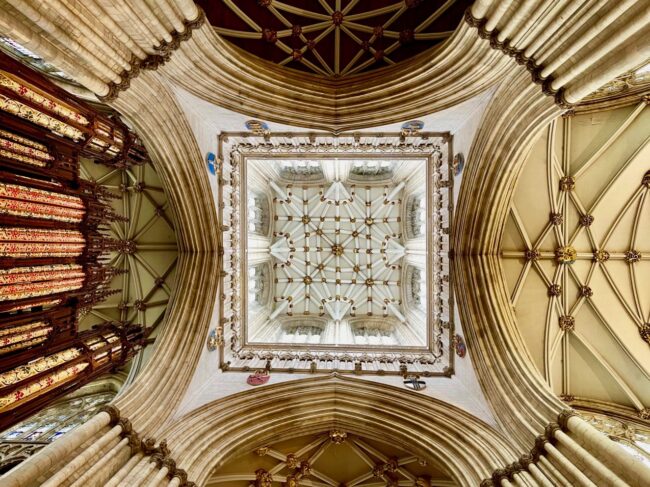
Since we only had a few hours remaining to explore York, we headed to the Merchant Adventurers Hall, deemed “one of the finest medieval guildhalls in the world.” On the way, we passed by a reportedly haunted pub named the Golden Fleece. Being short of time, there wasn’t a ghost of a chance we’d go in, however the sign on the right tells you who inhabits this building in case you’d like to have some spirits and pay these spirits a visit.
The Merchant Adventurers Hall’s construction began in 1357, and you can find different objects these “adventurers” collected along the way. The undercroft, which once served as a hospital for the poor.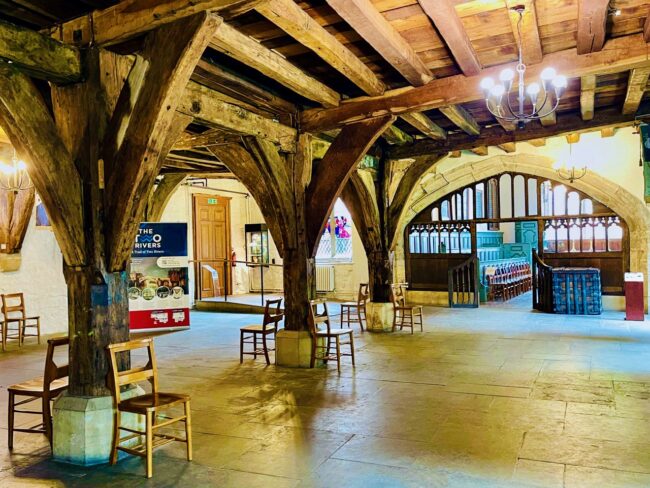
A chapel was built in 1411 for the use of the ill and poor in the hospital along with members of the Merchant Adventurers’ Guild.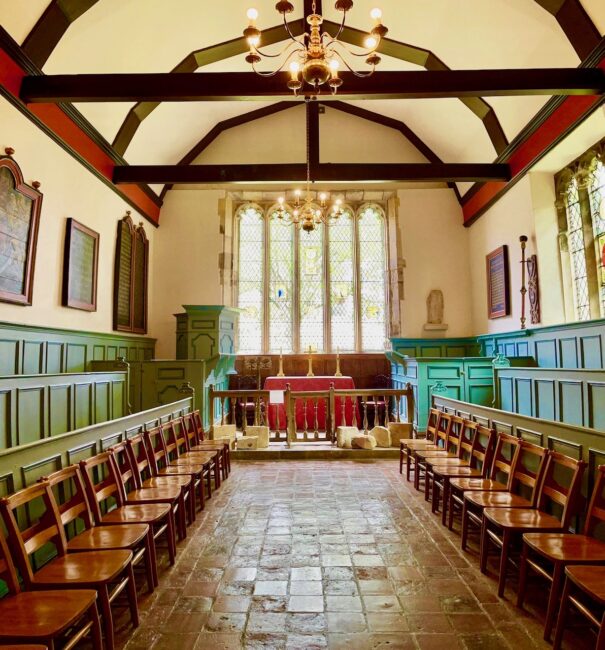
The Great Hall’s medieval timber frame is very impressive. This is the room where business and social gatherings took place. The fireplace dates from the 16th century. It’s the “largest timber-framed building in Britain still standing.”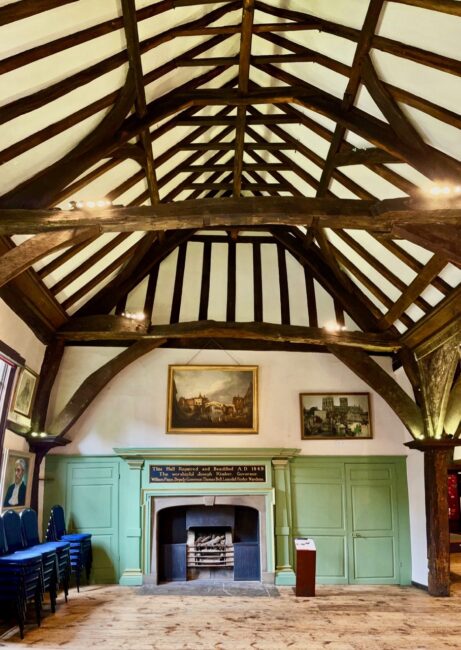
The green Governor’s Stall can be seen on the right. It was originally from York Castle.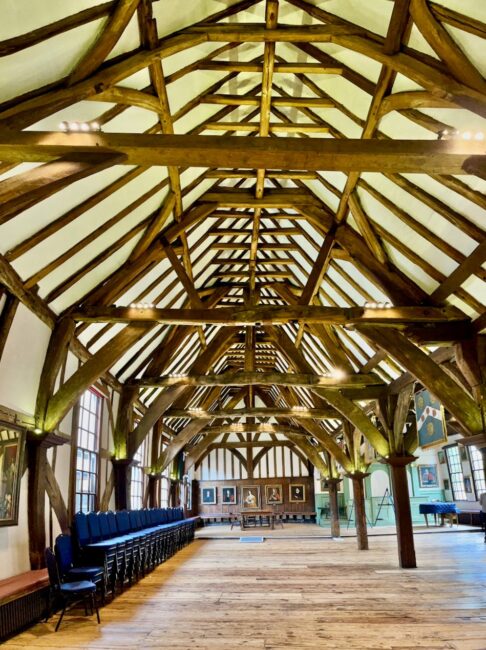
Numerous colorful banners hang here representing various city guilds or livery companies.
Lots of interesting items were on display.
The Governor’s Parlour, where business was conducted, features a beautiful table standing in front of a fireplace whose mantel is from the 16th century.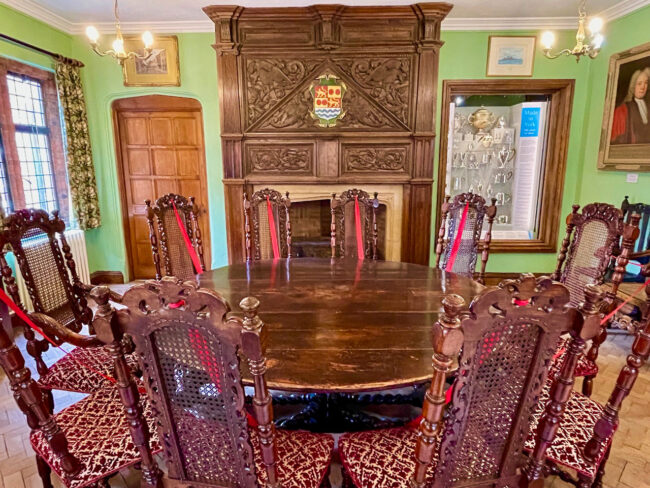
The stained glass window panels are from the late 18th or early 19th century.
There’s even a statue of Napoleon that was used to advertise snuff from the 1820s. The sign told about its interesting life. “During the Second World War he was ‘captured’ by a group of celebrating soldiers,” but was eventually rescued.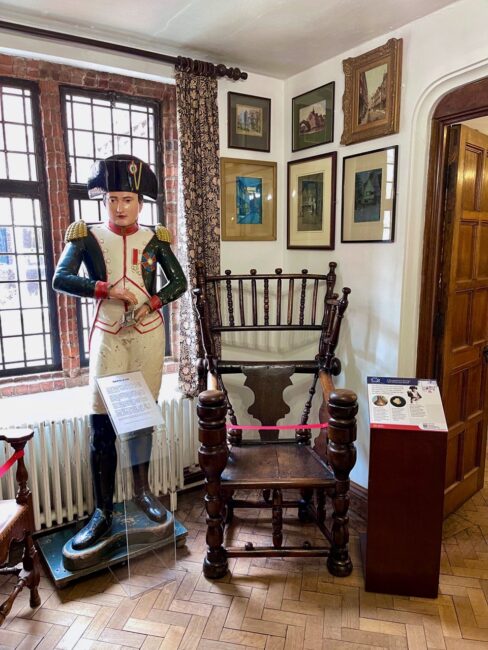
We needed a quick bite but since we had early dinner reservations we grabbed a very light second breakfast in the courtyard to tide us over.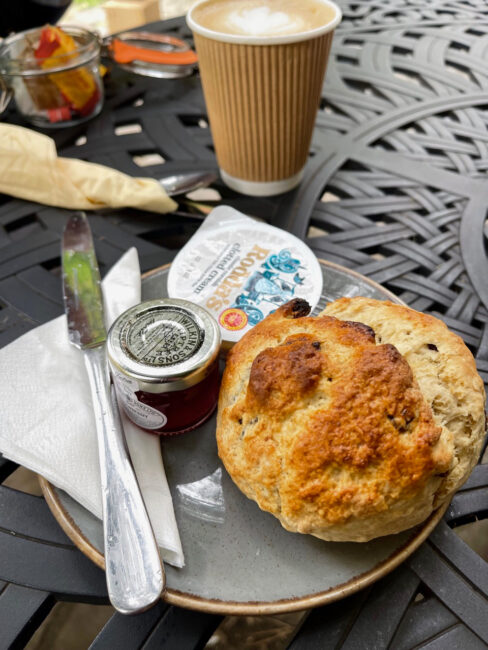
Kim looks as though he found out on his phone that the Padres had lost again. Even the bird looks depressed.
Following lunch we made a very quick stop at All Saints Pavement Church for a couple of quick photos.
Back on St. Helen’s Square, and that could only mean one thing …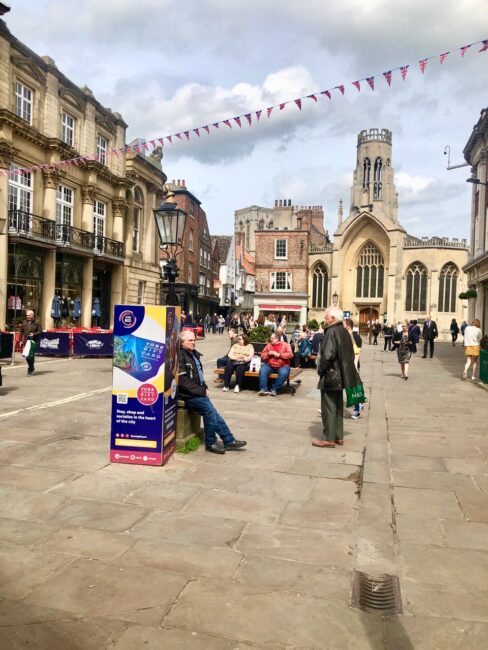
… we had returned to the Mansion House. We entered quietly in hopes that no one remembered the senile, old man from yesterday who attempted to crash Princess Anne’s parade.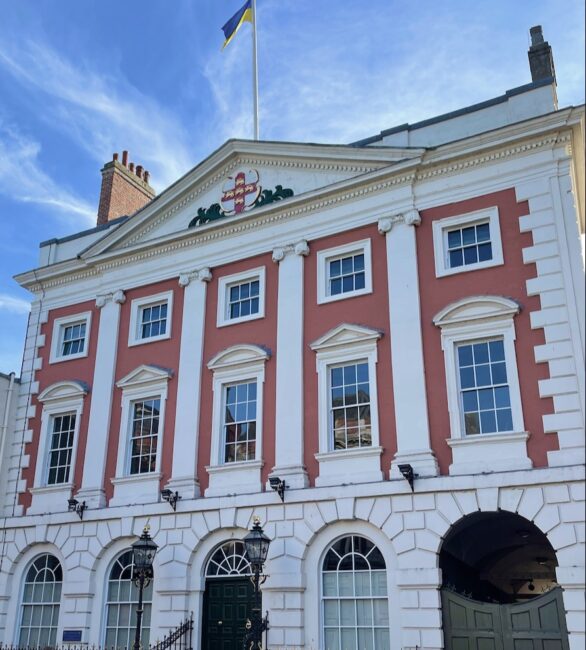
The Mansion House is the residence of the Lord Mayor and has been since the 18th century. It was established to “keep up the grandeur and dignity of the City,” which it nearly lost the previous day thanks to me. We took our self-guided tour, and were impressed by the stateroom. On the walls are paintings of former mayors.
In the dining room, Mary checked out the menu, and I swear to God I didn’t break that glass!
The kitchen is a “fully functional, recreated 18th-century kitchen.”
The William IV Race Cup is one of many artifacts here, along with the Great Mace. There’s also the 1672 Gold Cup … I just don’t know for what.
We also saw the oldest silver chamber pot in Britain. In 1672 Marmaduke Rawdon left the City of York 100 pounds in his will with the instructions the money be used to purchase a silver chamber pot and a gold cup. “The chamber pot is regularly placed on the dining table after the annual mayoral appointment. The cup is used each year to receive the Loyal Toast and to make special proclamations from the Mansion House steps.”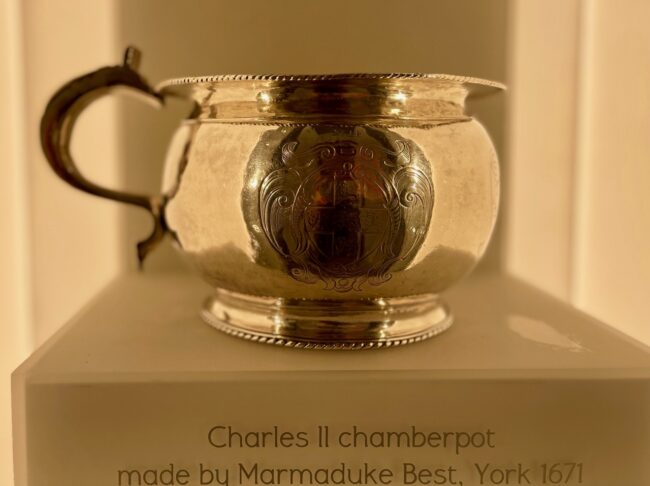
One of the most interesting items capped off our day at The Mansion House. The 1580 Cap Of Maintenance has nothing to do with janitorial services. “Tradition says that Richard II first awarded the Cap of Maintenance to York in 1396 and gave the city the status of a county.” The City of York insists this is the original Cap of Maintenance.
When we walked back near the River Ouse, we saw The Starr Inn The City, a restaurant that Julian on the train had recommended. Unfortunately, we would not be able to dine there nor did we remember to take a photo (this one from web). Next time.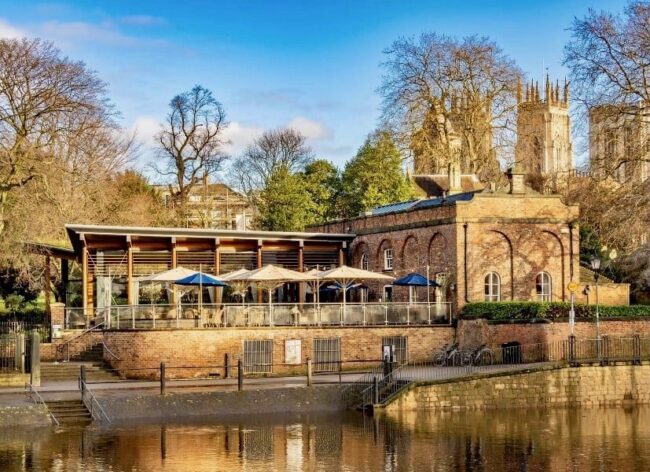
That night (or should I say late that afternoon), we dined at Rustique (our review here), where we had made reservations a couple of days before. 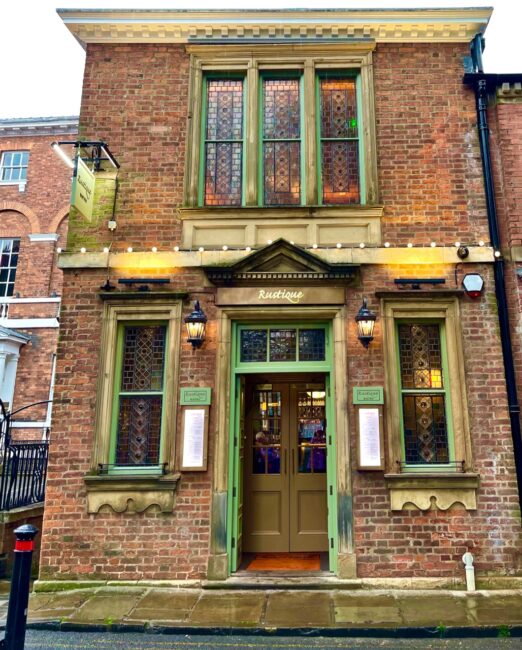
The early starting time was worth it, as dinner was excellent, including the best steak I’ve ever had in Europe.
It poured rain all through dinner, and we still had showers on the way back to St. Raphael Guesthouse. In our room, we were greeted by a gorgeous rainbow out of our windows, a perfect send off to a perfectly wonderful three days in the medieval town of York.
Time to hit the road the next morning.
 On our way to Durham, we’d stop by an incredible abbey and water park, plus another famed cathedral (they never end). In Durham we’d stay in the building where City Council Chamber debates were once held, and where I, on the following morning, would suffer through one of my most embarrassing moments while traveling … even more embarrassing than the Princess Anne fiasco in York.
On our way to Durham, we’d stop by an incredible abbey and water park, plus another famed cathedral (they never end). In Durham we’d stay in the building where City Council Chamber debates were once held, and where I, on the following morning, would suffer through one of my most embarrassing moments while traveling … even more embarrassing than the Princess Anne fiasco in York.
Next – CHAPTER SEVEN: An Abbey For The Ages & On To Durham
Day Seven: Home On The Grange, Dear Abbey, Studley, A Walk In The (Big) Park, Are We There Yet?, Celebrating 1,350 Years, Ready For A Big Night Out, Death Stairs & At Seventeen

